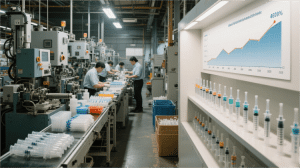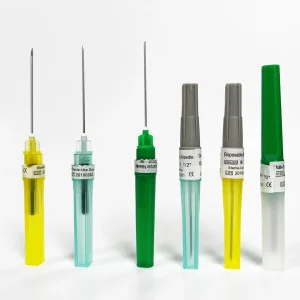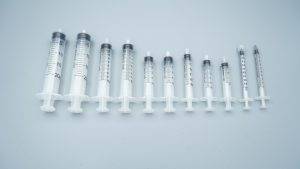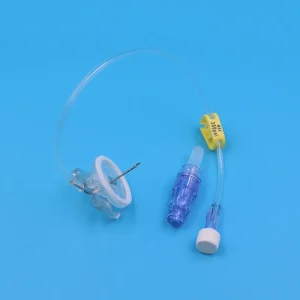As a leading medical syringe manufacturer, we understand that product quality is paramount to patient safety. Within Australia’s stringent medical device regulatory framework, proper understanding and management of medical syringe shelf life, storage conditions, and inventory turnover directly impacts both operational costs and the quality of patient care. This guide addresses the practical needs of diverse Australian customer segments, providing systematic insights into complete lifecycle management of medical syringes.
Understanding Shelf Life and TGA Compliance Requirements
Medical syringes typically have a shelf life of 3 to 5 years—a timeframe established through rigorous testing in accordance with Therapeutic Goods Administration (TGA) standards and international ISO certifications. This isn’t an arbitrary figure; it’s derived from accelerated aging tests, material stability analyses, and sterile barrier system integrity validations.
Key Point: The shelf life calculation begins from the manufacturing date, not the purchase date. Healthcare facilities must carefully verify batch numbers and expiration dates on packaging to ensure adequate usage windows.
For large hospital systems, we strongly recommend implementing a First-In-First-Out (FIFO) inventory management system. This approach prioritizes the use of medical syringes closest to their expiration dates, preventing waste of valuable medical resources. Australian healthcare facilities must also comply with TGA traceability requirements for medical devices, maintaining comprehensive procurement and usage records to enable rapid response during product recalls or quality investigations.
Important Reminder: Expired medical syringes compromise sterility assurance and mechanical performance. Never use products beyond their marked expiration date, regardless of apparent packaging integrity.
Critical Storage Conditions for Medical Syringes
The storage environment directly influences medical syringe performance and safety. Optimal storage conditions include:
- Temperature: Maintain between 15-25°C (59-77°F)
- Relative Humidity: Keep within 30-70% range
- Protection: Avoid direct sunlight and extreme temperature fluctuations
- Location: Store in clean, dry, well-ventilated dedicated areas
These seemingly simple parameters reflect deep understanding of material science. Polypropylene or polycarbonate syringe materials may undergo molecular degradation in high-temperature environments, while excessive humidity can compromise packaging seal integrity, threatening product sterility.
Regional Storage Strategies Across Australia
Northern Tropical Regions: Medical facilities should prioritize air conditioning system reliability, considering temperature and humidity monitoring equipment with emergency backup systems.
Southern Temperate Zones: While climate is relatively mild, facilities must guard against seasonal temperature variations that could affect medical syringe storage.
Remote Areas: Clinics and community health centres face longer transport cycles and should emphasize post-delivery storage environment checks, ensuring products haven’t been exposed to adverse conditions throughout the supply chain.
Physical Storage Layout Best Practices
Medical syringes should be stored on shelving or pallets elevated at least 10cm above floor level to prevent ground moisture penetration. Storage areas require strict access controls and regular cleaning protocols to minimize environmental microbial loads. Keep medical syringes away from chemical reagents, radioactive materials, and other potential contamination sources.
Professional Tip: Implement environmental monitoring systems that alert staff to temperature or humidity excursions, enabling immediate corrective action before product quality is compromised.
Multi-Dimensional Safety Assurance
Medical syringe safety encompasses every stage of the product lifecycle. As manufacturers, we ensure compliance through ISO 13485 quality management systems and ISO 11137 sterilization standards. Our packaging utilizes medical-grade Tyvek or medical paper-plastic materials, creating reliable sterile barriers while facilitating pre-use visual inspection.
Pre-Use Inspection Protocol
Healthcare staff should establish a routine pre-use inspection habit for every medical syringe:
✓ Check packaging integrity for tears, punctures, or seal failures
✓ Verify the product is within its expiration date
✓ Inspect for abnormal discoloration or foreign matter
✓ Ensure proper storage conditions have been maintained
Any suspicious product must be immediately quarantined and reported to quality management—never risk using questionable medical syringes, especially during Australia’s hot summer months or in remote areas with limited transport conditions.
Safety-Engineered Syringes
For facilities using safety syringes, incorporate proper activation technique into regular training programs. Needlestick injuries represent a major occupational hazard for healthcare workers, and safety-engineered medical syringes significantly reduce this risk. However, safety devices only achieve maximum effectiveness when operators fully understand their mechanisms and strictly follow operating procedures.
Training Recommendation: Conduct quarterly hands-on training sessions and competency assessments to minimize safety incidents caused by improper operation.
Optimizing Inventory Turnover and Cost Control
Efficient inventory turnover reduces expiration risks and capital holding costs while ensuring healthcare facilities consistently use medical syringes at peak performance.
Large Hospital Networks
Implement JIT (Just-In-Time) or Kanban inventory management systems that monitor usage rates and stock levels in real-time, achieving precise procurement and minimized inventory. This model works particularly well in major Australian cities where supply chain responsiveness supports frequent, small-batch replenishment.
Efficiency Metrics: Track inventory turnover ratios, expiration rates, and storage costs to continuously refine your medical syringe procurement strategy.
Small to Medium Clinics and Specialist Centres
Adopt periodic fixed-quantity procurement models combined with seasonal patient flow predictions. For example, influenza season vaccination clinics need advance medical syringe stockpiling, while elective surgery centres should adjust inventory flexibly based on surgical schedules. Analyzing historical usage data to build scientific procurement models maximizes supply security while minimizing inventory costs.
Remote and Mobile Healthcare Services
The challenge lies in balancing adequate stock with limited storage space and funding. We recommend these customers establish long-term supplier relationships to secure flexible delivery arrangements and consignment inventory options. Consider resource-sharing mechanisms with neighbouring facilities for emergency mutual support, improving overall regional medical resource utilization.
Digital Management Solutions
Barcode scanning systems, electronic inventory management software, and automated reorder alerts dramatically enhance turnover efficiency. These tools not only reduce manual counting workload and error rates but also provide detailed usage data for cost analysis and budget planning. For healthcare facilities pursuing lean management, these investments deliver substantial medium to long-term returns.
Technology Integration: Modern inventory management systems can integrate with hospital information systems (HIS), creating seamless workflows from medical syringe requisition through usage documentation.
Supplier Partnership and Quality Assurance
Selecting the right medical syringe manufacturer and distributor is crucial. Look for suppliers who:
- Hold current TGA registration and compliance certifications
- Provide comprehensive product documentation and certificate of analysis
- Offer responsive technical support and customer service
- Maintain reliable supply chain infrastructure across Australia
- Demonstrate commitment to continuous quality improvement
Establish clear communication channels with your medical syringe supplier regarding product specifications, delivery schedules, and quality concerns. A strong supplier partnership ensures consistent product quality and reliable availability.
Conclusion
Medical syringe storage and management represents a comprehensive system encompassing product knowledge, regulatory compliance, environmental controls, staff training, and information technology. As a medical syringe manufacturer, we’re committed to providing products that exceed Australian TGA standards while serving as your trusted partner in safeguarding patient safety and healthcare service quality.
Through proper understanding of medical syringe shelf life, strict adherence to storage protocols, enhanced safety awareness, and optimized inventory turnover, Australian healthcare facilities can achieve regulatory compliance while realizing operational excellence—delivering safer, more efficient healthcare services to communities nationwide.
For more information about our medical syringe products and storage solutions, contact our Australian customer service team or visit our technical resources portal.





